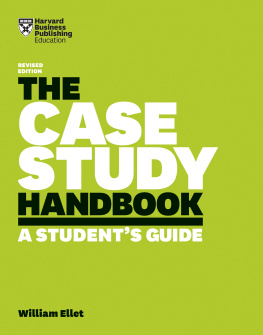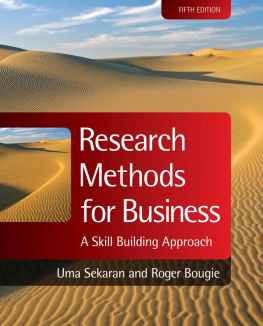Harvard Business Review Press titles are available at significant quantity discounts when purchased in bulk for client gifts, sales promotions, and premiums. Special editions, including books with corporate logos, customized covers, and letters from the company or CEO printed in the front matter, as well as excerpts of existing books, can also be created in large quantities for special needs.
For details and discount information for both print and ebook formats, contact .
No part of this publication may be reproduced, stored in or introduced into a retrieval system, or transmitted, in any form, or by any means (electronic, mechanical, photocopying, recording, or otherwise), without the prior permission of the publisher. Requests for permission should be directed to , or mailed to Permissions, Harvard Business School Publishing, 60 Harvard Way, Boston, Massachusetts 02163.
INTRODUCTION
A re you a student who is new to the case method? Are you a student who feels that you arent learning as much as you want from the case method? If you belong in either of these categories, this book was written for you.
The first edition of The Case Study Handbook emerged from my sixteen years of work with business school students. This new version follows over a decade more of working with students and refining the ideas in the first edition. The initial motivation for the book was frustration. I had been trying to help Harvard Business School MBAs write better case-based examinations. I gave them what I considered to be good advice about writing, such as using a logical essay structure and being concise. There was nothing wrong with the adviceIm still giving it to this daybut it didnt have the positive impact I expected on the quality of students exam essays.
Eventually, I realized that I didnt fully understand what the students were having trouble with. First, my advice started in the wrong place. I assumed that students knew how to analyze cases to provide the content needed for their exam essays. Actually, many werent sure how to do that. Their uncertainty compromised the depth and quality of their thinking about cases.
Second, case examinations usually ask students to take a position on the central issue of a case. Although many students had no problem taking a position, they werent certain what else they needed to do. A common strategy was to fill the essay with case facts the students thought were relevant to their position and let the reader sort out the relationship between the facts and the position. I assumed that they knew how to write an argument to prove their position.
The two issues had nothing to do with how smart the students were. They werent at fault for not knowing what they needed to do because no one had ever told them. Students are usually expected to figure out how to analyze cases on their own. Many do and many dont. But the process of making cases meaningful is too important to leave to chance. The rich learning that the case method offers cant be completely realized unless studentsmeaning youunderstand what a case is and how to analyze it. The same is true of understanding how to make evidence-backed arguments.
One other aspect of the case method causes problems for a significant number of students: classroom discussion of cases. Theyre unsure of the purpose of discussion and their role in it. Much of this uncertainty stems from students educational backgrounds. Theyre used to the lecture method and have honed the skills needed for that method of instruction: listening and taking notes. They emphatically arent used to the professor asking them questions or having a major share of the responsibility for learning in the classroom.
Its telling that three critical aspects of the student role in the case methodanalysis, discussion, and argumentare often ignored. The case method has been defined largely from the point of view of professors, not students. Professors concern themselves with analyzing cases in order to teach them and are skilled in argumentation. However, what matters most in the classroom is what students, not professors, knowor dont.
Im not blaming professors. Theyre focused on their subject-matter expertise, and the academic reward system tends to be biased toward what the professor knows, not how well she or he can teach that knowledge. Showing students how to analyze cases and make arguments about them falls outside the lines of business disciplines and the organization of business departments or schools. Youll look in vain for a Department of Case Analysis.
This book fills the gap Ive just described in traditional business curricula. (It also is relevant to programs other than business that use cases, including medicine, nursing, and engineering.) It provides:
- Analytical tools that help you sort, organize, and reflect on the content of a case and use the concepts and frameworks taught in business courses more effectively.
- Advice on how you can participate in and contribute to classroom discussion of cases.
- Guidance on how to develop arguments about cases and express them in writing that is logical, clear, and succinct.
Its a fair question to ask whether the advice in this book works. Is it worth your time to read? Heres what I can tell you. For over a decade since the publication of the initial edition, a group of writing coaches, including me, has used the first edition of the book as a foundation for our work with hundreds of Harvard MBAs. Almost all of our students significantly improved their ability to analyze cases and to write about them. Our metric was the grades that students received. Ive had similar results in my teaching at Brandeis University, George Washington University, and the University of Miami.
One of the best examples from my own coaching is a first-generation college graduate from a family that had emigrated to the United States when he was a child. He received poor grades on his first-year exams at HBS and was understandably demoralized. He used the concepts in this book to enhance his understanding of how to analyze a case and write a persuasive argument about it. In his second year, he received high grades in all of his coursesa complete turnaround from his first year. There were several reasons for his academic improvement, the primary one being his hard work. But he said he also benefited in class discussion and on exams from the concepts drawn from this book.
This book uses Harvard Business School cases as examples and includes analyses of them. Dont assume, however, that the analyses give the right answers to the cases. The evidence in them can sustain other conclusions. The book also includes essays about the cases; they are based on the writing of MBA students. Because the original essays were examinations written under time pressure, they inevitably had errors, unclear sentences, and lapses in logic. I debated whether to present the essays as is or correct and revise them. I chose the latter. No essay is perfect, and I dont want to set a standard of unobtainable perfection. But I want you to have the best examples of the points made in the book without confusion over what is correct and what isnt.
This book is intended for youcase method students current and prospective. My wish is that it will enhance your learning from cases and provide benefits for others associated with your learningyour peers, professors, employers, colleagues, and communities.






